Bulletin – December 2015 Finance Trends in Australian Corporate Financing
- Download the article 356KB
Abstract
The aggregate funding behaviour of the Australian non-financial corporate sector has been fairly steady over the period since the global financial crisis. However, this masks the quite divergent experiences of the resources and non-resources sectors. Substantial net investment by resources companies has been funded primarily by operating cash flows, while external funding has been modest, mainly comprising borrowing to offset the effect of movements in commodity prices on internal funding. Net investment by non-resources companies has been relatively subdued, with internal funds broadly sufficient to meet this expenditure. Overall, leverage for Australian-listed companies remains relatively low, internal funding continues to cover the bulk of financing needs and companies generally appear to retain good access to external finance in its various forms.
Introduction
The overall demand for finance reflects the investment decisions of the corporate sector. Companies finance their business activity from a mix of internal and external sources. Internal finance flows directly from company operating cash flows, while external funds are sourced from banks, or through the issuance of debt or equity securities. Internal finance is generally less variable compared with the use of external finance and tends to provide the bulk of funding for most activities. External finance is often used to facilitate larger, discretionary expenditures, including mergers and acquisitions (M&A).
Since the global financial crisis, investment and corporate funding trends in Australia have been characterised by the divergent experiences of the resources sector and non-resources companies.[1] Resources companies undertook a large increase in investment, which involved substantial long-term commitments to investment projects. In this environment, resources companies increased the share of debt in their funding during periods of weakness in operating cash flows. In contrast, investment in the non-resources sector has been much weaker, largely limited to maintaining the asset base rather than expansion. Internal finance has been adequate to meet non-resources companies' net funding needs and the sector's capital structure has remained more stable.
The resource investment boom contributed significantly to the relatively favourable performance of the Australian economy in the post-crisis period. Australian business investment increased considerably, unlike in many other developed economies where investment was more subdued (Graph 1). Consistent with this, leverage of the Australian corporate sector increased modestly after 2010, while leverage continued to decline in many other developed economies (Graph 2).
In aggregate, listed non-financial companies' sources and uses of funds have been relatively stable in the post-crisis period, generally close to 10 per cent of nominal GDP and only slightly below the averages since 2000 (Graph 3).[2] Net investment has continued to be funded mainly through internal sources, while the use of external finance has remained limited.
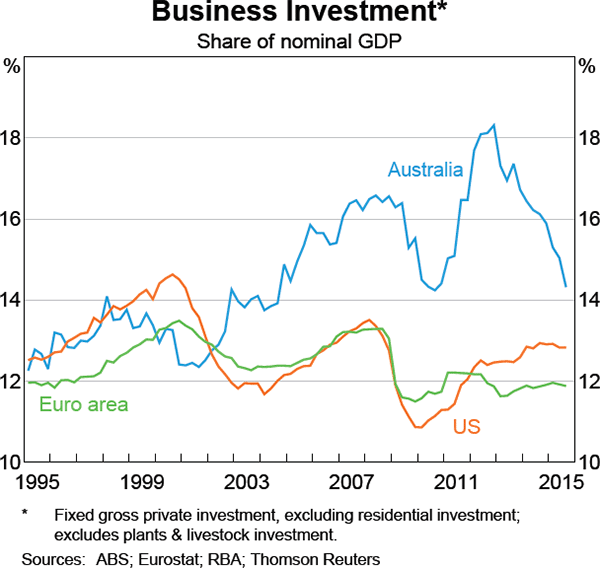
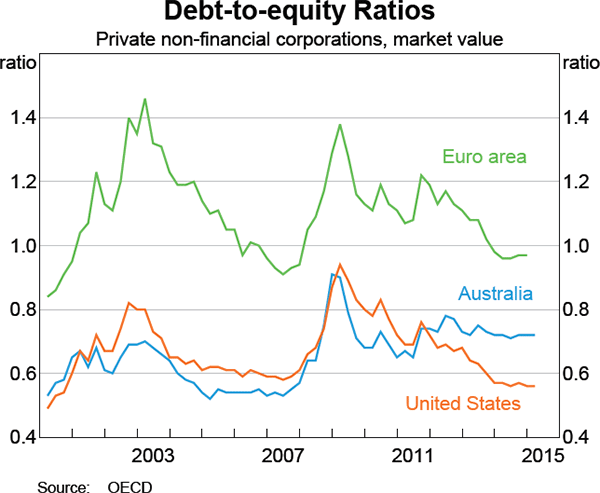
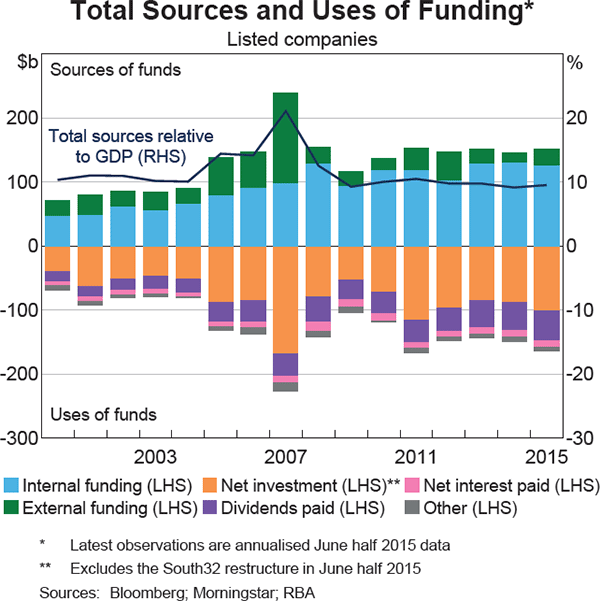
Companies' Uses of Funds
A modest increase in listed companies' uses of funds since the global financial crisis has occurred largely due to higher net investment (Graph 4).[3] The other main trends evident in the uses of funds data over the post-crisis period include lower net investment outside the resources sector, notably in the real estate and ‘other’ sectors, and an increase in dividends paid.[4] Interest payments remain a modest component of the uses of funds and have decreased in aggregate since the sharp deleveraging that occurred immediately following the crisis. Also, this decrease has been accentuated by the decline in borrowing costs.
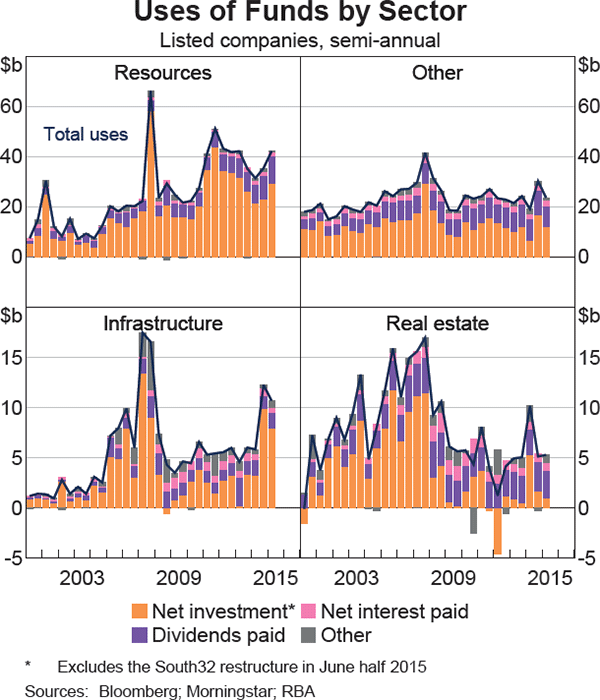
Investments
Net investment comprises net physical investment, net acquisitions and other investment.[5] Prior to the global financial crisis, listed companies underwent a period of M&A-driven investment expansion, participating in the global wave of such activity (Graph 5). Much of the M&A activity was undertaken by non-resources companies, which were typically mature firms with fewer organic growth opportunities. M&A by companies within the other sector accounted for a lower share of investment than either the real estate or infrastructure sectors, but the transactions were large and occurred across many industries.[6] Net acquisitions by resources companies typically accounted for a much lower share of net investment, due to the availability of organic growth opportunities. Very large transactions occurred sporadically in the sector, including Rio Tinto's $44 billion acquisition of Alcan in 2007 – the largest by an Australian listed company.
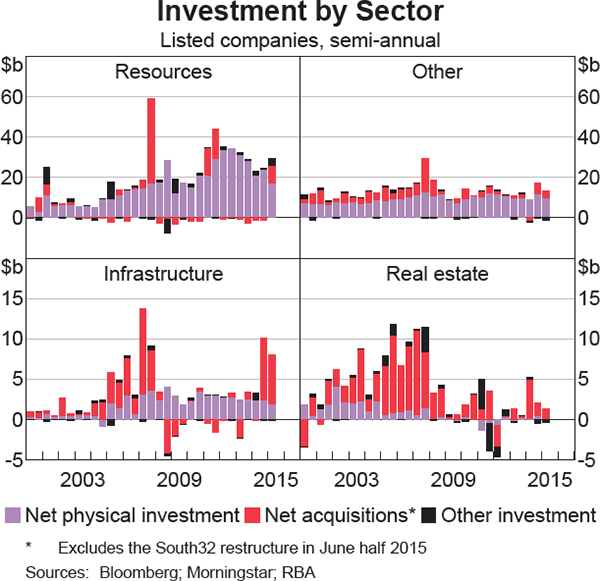
The global financial crisis marked a shift in corporate attitudes towards expansion, owing to the heightened sense of uncertainty and weak economic outlook. This shift ushered in a period of restraint in capital and other expenditures resulting in a protracted period of subdued M&A activity by Australian companies. The most notable activity was a small number of resources-sector transactions over 2010–11.[7] Since mid 2014, there have been some signs of a return of M&A activity, but primarily among resources and infrastructure companies.
Physical expansion by diversified mining companies has been the major source of net investment by listed Australian companies since the crisis. The elevated level of commodity prices spurred mining companies to develop new projects and expand existing sites to upgrade production capacity, particularly for projects involving iron ore. Companies also invested to expand coal production capacity due to robust foreign demand for its use in the manufacturing of steel. Physical investment in large-scale liquefied natural gas (LNG) projects has been substantial, although the true scale of these investments is under-represented by these figures owing to foreign participation in the projects.[8] Over the past three years, however, investment in the resources sector has declined as existing projects moved into the production phase. Uncommitted expenditure has also been deferred in part as lower commodity prices have reduced the attractiveness of many projects. Shareholder pressure to exercise capital expenditure restraint may also have contributed to this trend, particularly as companies recorded substantial write-downs of many assets acquired over recent years.
Other companies (those not categorised within the resources, infrastructure or real estate sectors) have been the main source of net physical investment outside the resources sector since 2008, with much of this investment undertaken by companies with cyclical business activities (Graph 6).[9] This largely reflects net physical investment by resources-related industrials, with the expansion and subsequent contraction of activity in the resources sector driving investment decisions. Other non-cyclical companies remain the most significant source of investment not directly related to the resources sector, largely reflecting physical investment by consumer staples and telecommunications companies to maintain assets.
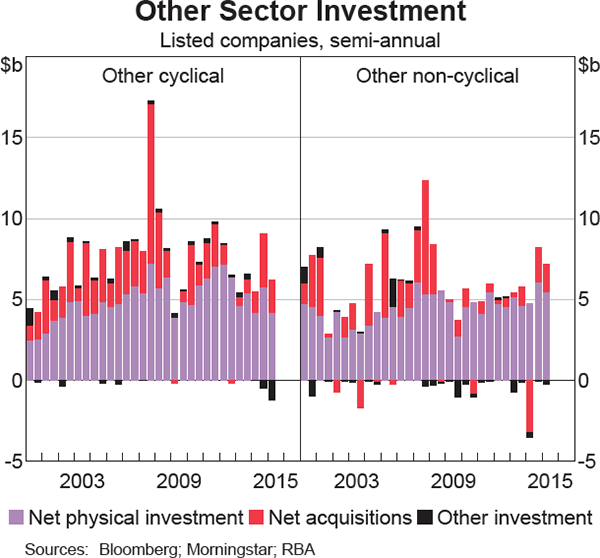
Dividends
Companies have generally increased dividends over recent years, after the reduction in dividend payments immediately following the global financial crisis (Graph 7). Subdued investment by non-resources companies has coincided with an increase in dividend payments relative to total uses of funds, but dividends have generally moved closer to their average proportion of operating cash flows. The resources sector has raised dividends most sharply, despite substantial investment commitments. As a result, dividends have risen in aggregate as a share of operating cash flows (and earnings) but remain well within historical norms.
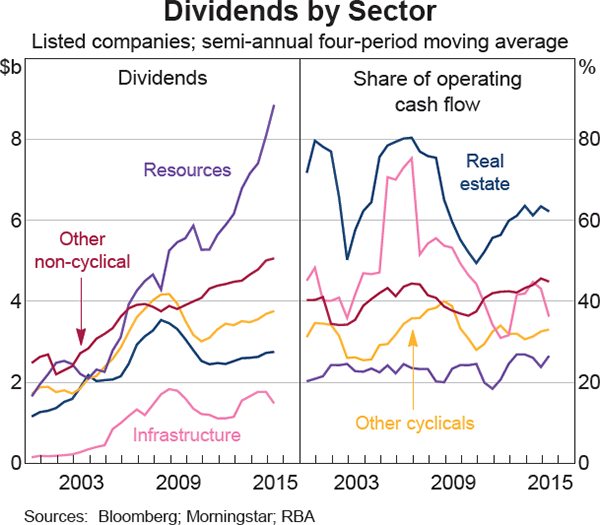
Funding the Listed Corporate Sector
As noted previously, the business activities of Australian listed companies are mostly funded from internal sources, effectively recycling returns on previously invested capital to sustain operations and undertake new investment. Internal funding has accounted for around two-thirds of total funding since 2000, although the pre- and post-crisis periods produced two distinct funding phases. The phase preceding the crisis was characterised by a steady increase in the availability of internal funding, particularly within the resources sector as rising commodity prices drove substantial growth in operating cash flows. Non-resources companies funded much of their acquisition-driven expansion through external sources, given that the transactions were large relative to internal funding.[10]
The post-crisis phase has been characterised by the modest use of external funding across listed companies (Graph 8). This has consisted mostly of resources companies sourcing external finance to meet committed physical investment outlays during periods when lower commodity prices reduced operating cash flows. Meanwhile, non-resources companies had little demand for net external funding. During the past two years, there have been tentative signs of a pick-up in the use of external funding reflecting a recovery in initial public offering (IPO) activity during 2014 and the use of debt to finance acquisitions particularly in the resources and infrastructure sectors.
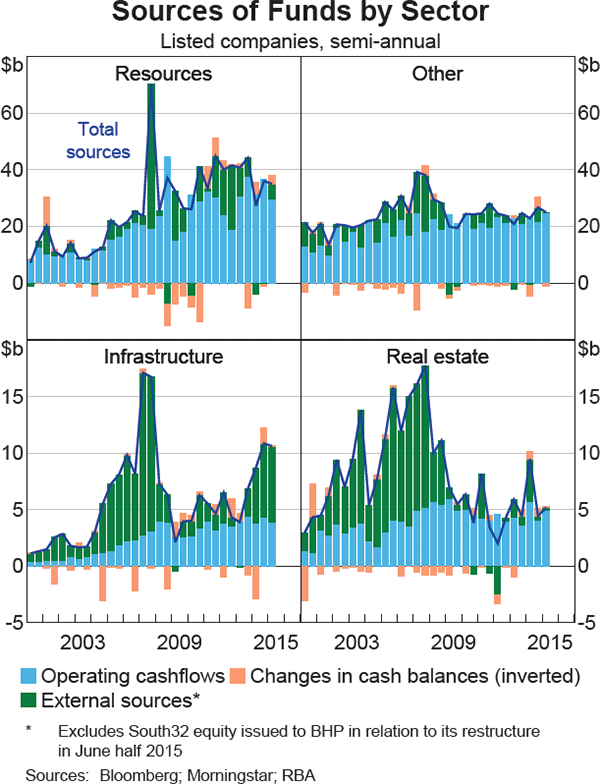
Internal funding
The ability of companies to fund themselves internally from current period operating cash flows has generally been quite stable at around 10 per cent of companies' total assets (Graph 9). This stability of internal funding has been particularly evident for non-resources companies. At the same time, resources companies have become an increasingly important source of profits in the Australian listed sector over the past decade, growing to account for roughly half of total operating cash flows. This has added to the volatility of aggregate internal funds because resources companies' earnings have significant exposures to movements in commodity prices.
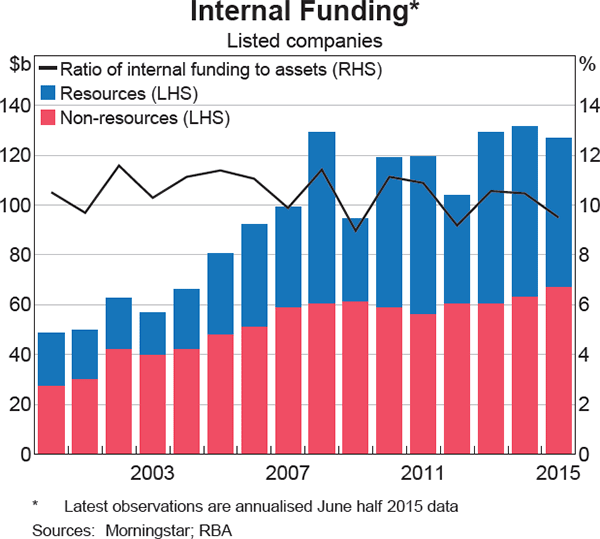
For both the resources and non-resources sectors, current-period operating cash flows comprise the bulk of internal funding (Graph 10). Companies may also use their cash balances as a source of internal funds.
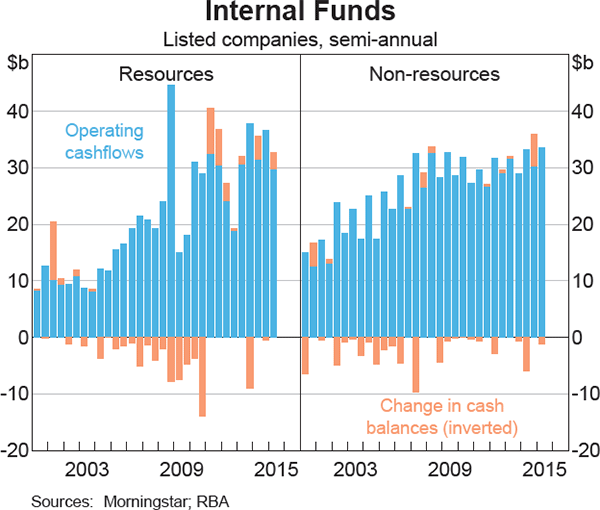
The intensification of the global financial crisis in late 2008 and growing concerns around European sovereign debt in 2010 coincided with a pronounced increase in cash balances for resources companies, consistent with decisions to curtail investment expenditure. The recovery in commodity prices in 2011 and the subsequent recovery in net investment was funded in part by a reduction in resources companies' cash balances, although cash holdings relative to assets remained above pre-2008 levels.
For non-resources companies, there was a smaller increase in cash balances immediately following the crisis and, over more recent years, balances generally declined or remained steady in dollar terms and as a proportion of assets (Graph 11 and Graph 12).
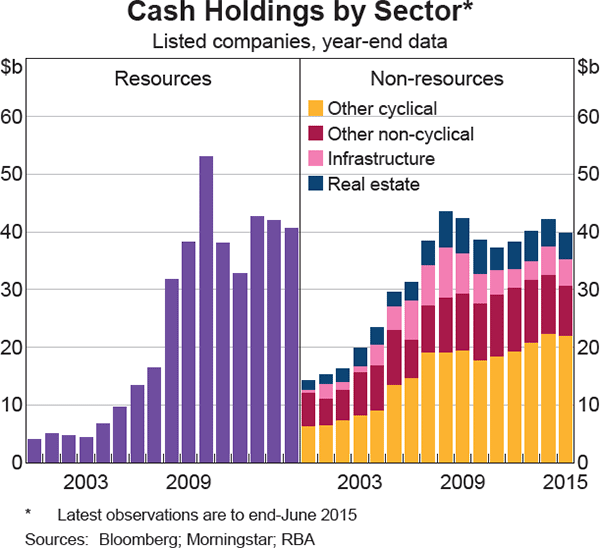
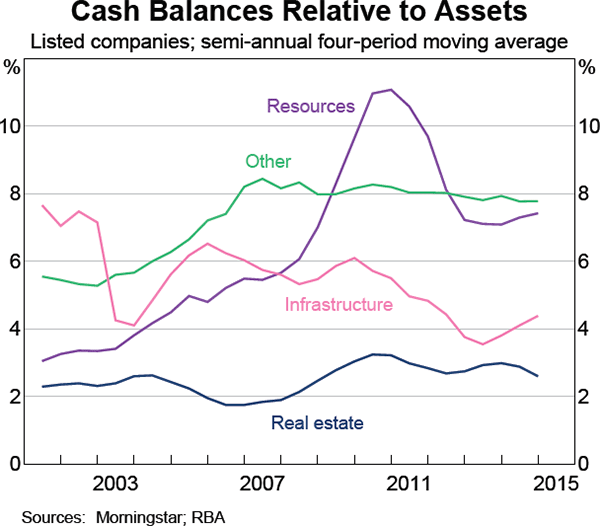
External funding
Use of external funding increased considerably during the pre-crisis phase but moderated over the post-crisis period (Graph 13). Debt is typically the preferred source of external finance and was used extensively to fund the wave of M&A activity prior to 2008, causing net debt cash flows reported by listed companies in aggregate to peak at 15 per cent of GDP in 2007. Since the financial crisis, the net external funding needs of listed companies have largely consisted of the debt raised by resources companies to fund committed physical investment, although this has slowed since 2013. Limited net investment by non-resources companies has meant that internal funds have mostly been sufficient to meet expenditure, particularly given the low level of M&A activity between 2008 and 2014. Over the past year, non-resources companies obtained funds from debt markets, while in aggregate it is estimated that bank debt has been reduced.
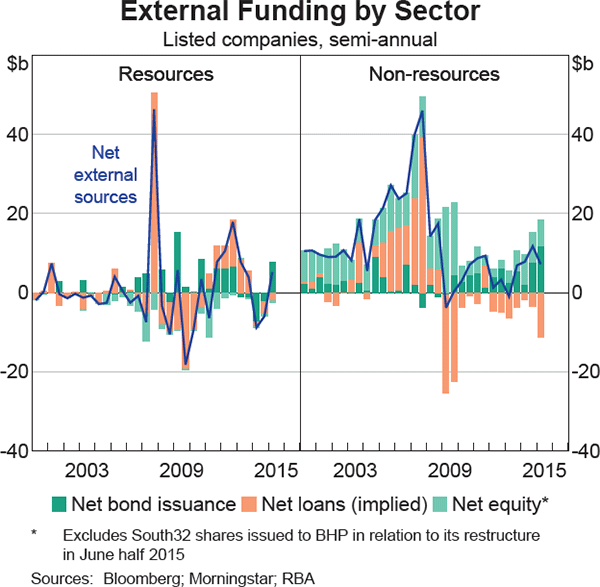
Net equity raisings have generally been modest, abstracting from the surge in issuance that coincided with the peak in equity prices prior to the global financial crisis and the subsequent equity-funded, market-wide deleveraging during 2008–09.[11] The past two years have seen some increase in net equity raisings, with much of this reflecting a return of IPO activity in 2014.
Debt funding
The level of debt of the resources sector is relatively modest compared with that for the non-resources sector. Notwithstanding the stability of net borrowing by non-resources companies, each year they refinance around $100 billion of debt (Graph 14).
Most corporate debt takes the form of loans, which comprise around three-quarters of economy-wide debt finance for non-financial companies, reflecting the dominance of the major Australian banks as suppliers of funding. The available data (as at mid 2015) for the debt structure for ASX 200 companies (which use bonds to a far greater extent than smaller and unlisted companies) suggest that loans tend to be used to complete funding requirements at shorter tenors (Graph 15). This is consistent with a preference of banks to lend for terms of between three and five years.
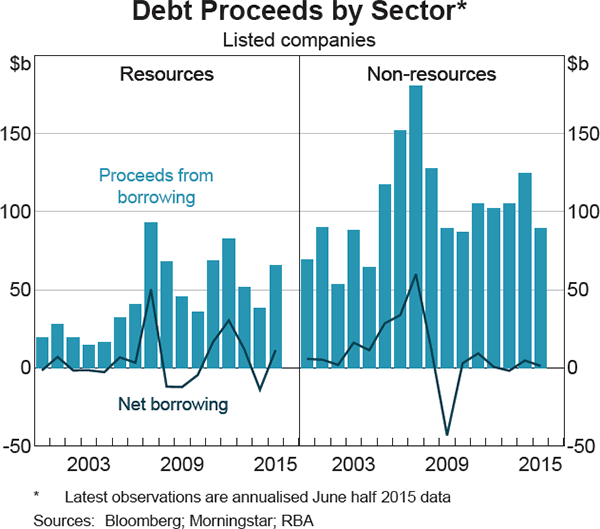
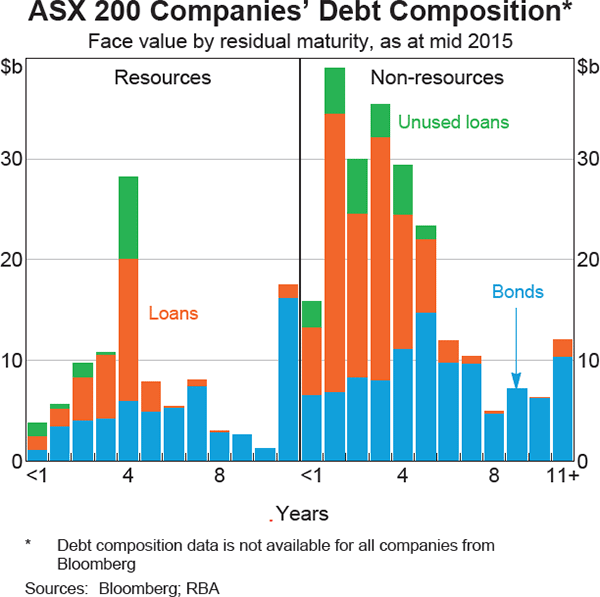
Many listed companies also find it attractive to issue bonds. Resources companies, particularly the major diversified mining companies, regularly raise debt through bond issuance due to their large borrowing requirements and relatively high credit ratings (Graph 16). Issuance by resources companies is typically offshore and mostly denominated in US dollars. Offshore issuance can access large markets where longer terms are more common than in the domestic bond market, allowing these companies to better match their funding term with the life cycle of investments in natural resources projects. Foreign-denominated bond issuance also serves as a natural hedge for commodity export revenues, which are typically denominated in US dollars.
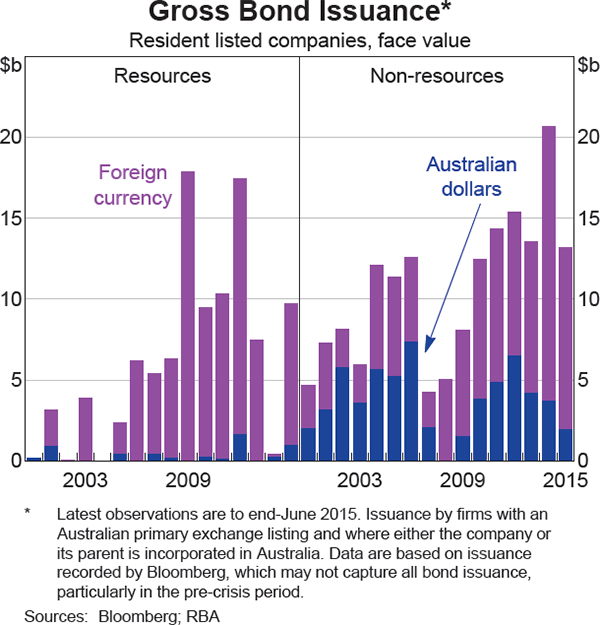
Non-resources companies also access bond markets to refinance their outstanding debt, often using the domestic corporate bond market. The main issuers are large companies with lower earnings volatility, particularly those in the consumer staples, telecommunications and utilities sectors.
Equity funding
Net equity raisings are a modest component of listed companies' external financing mix and activity was very subdued for a number of years after the global financial crisis (Graph 17). The increase in issuance since late 2013 reflects a pick-up in IPOs in the non-resources sector, with 2014 the strongest year for IPO issuance since the Telstra float in 1997. Private equity interests have been involved in many of these IPOs, with owners taking advantage of favourable market conditions and resurgent appetite from institutional investors. Market conditions in the year to date have been less favourable and IPO activity has slowed. The amount of equity raised by the resources sector since the crisis has been modest. Issuance tends to be concentrated among junior exploration companies, which rely almost exclusively on equity financing due to the speculative nature of their activities (Williams 2012).
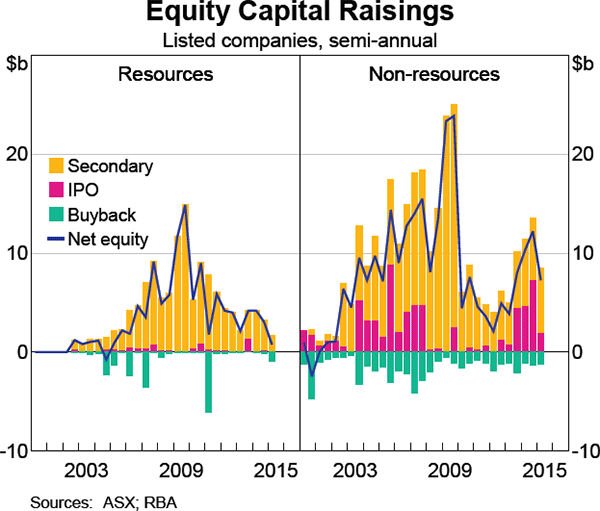
Costs of external finance
Companies' external funding choices are influenced by the relative costs of funding sources (Graph 18). A number of methods are used to approximate the cost of equity because it is not easily observable. However, these approximations generally imply a higher cost of equity than of debt, consistent with the existence of an equity risk premium. This is also consistent with a general preference for companies to raise debt before equity.[12] Graph 18 shows a range of estimates based on two simple approximations of the cost of equity, compared with observable costs of debt.[13] In general, the higher cost of equity funding has meant that companies have tended to raise equity sparingly, such as to reduce leverage or where access to debt markets is constrained due to unfavourable market conditions. This was evident in the 2009 equity-financed deleveraging, which occurred against the backdrop of a significant change in the relative costs of debt and equity.
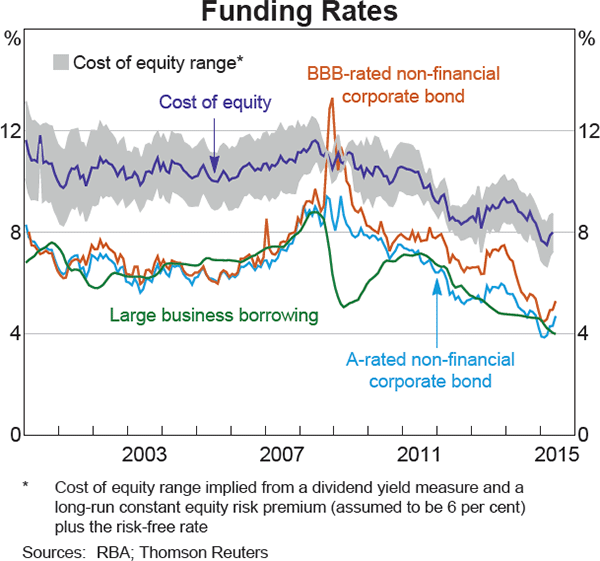
Leverage and Capital Structure
The aggregate capital structure of Australian listed companies has varied considerably over time, reflecting the investment cycle and shifts in the use of the different forms of external funding. Nevertheless, listed companies have historically maintained aggregate gross leverage of around 60 per cent on a book-value basis, with considerable variation between sectors (Graph 19). Resources companies maintain relatively low levels of gearing, reflecting a desire by firms to ensure that they can service debts in the face of volatility in earnings. The use of debt to fund part of the increase in net investment by resources companies from 2010 saw leverage roughly double to around 47 per cent by 2013, which is around the long-run average for the sector. Over the same period, assets within the resources sector have increased by over 40 per cent, reflecting high levels of physical investment.
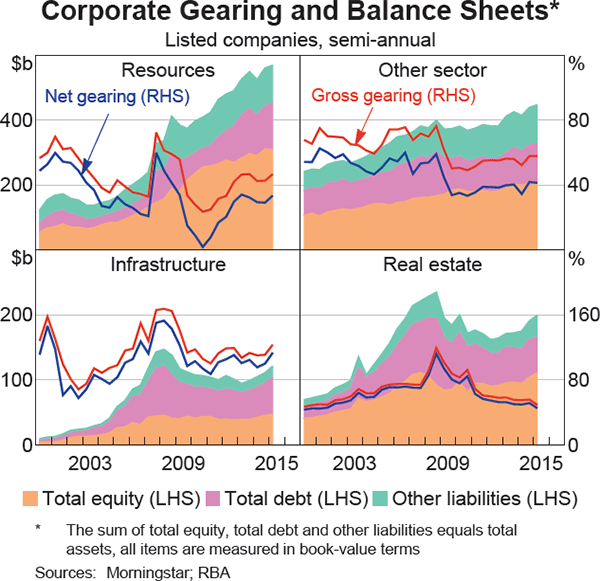
In contrast, modest net investment by non-resources companies has resulted in a period of relative stability in capital structure. Leverage of the other sector has remained around 55 per cent as many companies limited physical investment to levels just sufficient to maintain their asset base. The more highly leveraged companies in the real estate and infrastructure sectors tended to maintain or reduce leverage in recent years. Infrastructure companies remain geared above 100 per cent of equity, consistent with the defensive characteristics of these firms' assets (including their long-term, tangible asset base and relative stability of expected earnings).
Conclusion
The experiences of the resources and non-resources sectors have produced distinct trends in the corporate financing of Australian companies since the global financial crisis. Resources companies have funded a large increase in net investment primarily through internal sources. Net external funding was generally used when resources companies increased debt to finance committed investment expenditure in the face of lower commodity prices, which reduced the availability of internal funding. The capital structure within the resources sector has changed modestly as a result, raising leverage to around its average level since 2000. Resources companies have also increased their dividend payments substantially. In contrast, net investment by non-resources companies has been mostly confined to sustaining the existing asset base. Internal funds have been sufficient to meet this expenditure and their capital structure has changed little as a result. These companies have also increased dividends, though not beyond historical norms as a proportion of earnings. Overall, leverage for Australian listed companies remains relatively low, internal funding continues to cover the bulk of funding needs and companies generally appear to retain good access to external finance in its various forms.
Footnotes
The authors completed this work in Domestic Markets Department. An earlier version was presented at the 19th Melbourne Money and Finance Conference ‘Current Issues in Australian Financial Markets’, 28–29 July 2014 (Fang, Kosev and Wakeling 2014). [*]
See Black, Kirkwood and Shah Idil (2009) for a detailed account of developments in the sources and uses of funds by Australian companies preceding and during the global financial crisis. For a more detailed account of the funding of the resource investment boom in Australia since 2003 see Arsov, Shanahan and Williams (2013). [1]
Sources and uses data are compiled by aggregating the cash flow statements of listed Australian companies. Cash profits are not always the same as accrual-based accounting profits, which can be affected – at times significantly – by non-cash items such as asset revaluations. For more detail and background on the sources and uses of funds, see Black et al (2009). [2]
This analysis discusses net investment categories in the context of a cash flow statement; net investment is net of asset sales but not depreciation. [3]
The broad sector classifications adopted in this analysis are resources, infrastructure (mainly industrials and utilities), real estate and other, which in aggregate allow for comparison with the Australian Bureau of Statistics' definition of private non-financial corporations. [4]
In these data, net physical investment includes companies' purchases less sales of assets used in ongoing operations or which maintain or increase productive capacity, including property, plant and equipment and intangible assets (transactions in financial assets are not included). Similarly net acquisitions mainly includes purchases less sales of other companies (in whole, or in part), it does not include asset revaluations. [5]
A number of notable transactions occurred during this time, including Toll Holdings' $6 billion acquisition of Patrick in 2006, Wesfarmers' $22 billion acquisition of Coles in 2007 and Primary Health Care's $3.5 billion acquisition of Symbion in 2008. The restructuring of the Australian media industry occurred in 2007/08, with the creation of Seven Group Holdings and the spin-off of its media assets, along with the demerger of Publishing and Broadcasting Limited into Crown and Consolidated Media Holdings. [6]
These include Newcrest's $10 billion acquisition of Lihir Gold in 2010 and BHP Billiton's $11 billion takeover of Petrohawk Energy in 2011. [7]
Foreign-listed companies own large shares in many LNG projects run jointly with Australian companies. Around four-fifths of funding for physical investment has been sourced from offshore, meaning the associated investment outlays of foreign companies are omitted from this analysis. [8]
The other cyclical sector includes companies from the industrial, consumer discretionary and information technology Global Industry Classification Standard (GICS) sectors; the other non-cyclical sector includes companies from the consumer staples, health care, telecommunications and utilities GICS sectors. For both categories, other excludes companies already captured within the infrastructure sector. [9]
Increased use of external financing in the pre-crisis period is also consistent with literature suggesting firms attempt to time their capital structure decisions to raise equity when market values are high relative to book values (Baker and Wurgler 2002). [10]
For further discussion of the 2008–09 equity-financed deleveraging see Black et al (2009). [11]
This outcome is also consistent with the pecking order theory of capital structure which suggests firms prefer internal funding, followed by debt, and lastly will raise equity if required to finance investment (see Myers 1984, 2001; Myers and Majluf 1984). [12]
This analysis approximates an upper bound for the observed cost of equity using the long-run Australian historical equity risk premium of 6 per cent plus the risk-free rate approximated by the 10-year Australian Government bond yield (see Brailsford, Handley and Maheswaran (2012) for further detail on calculation of the equity risk premium). The lower bound for the cost of equity is implied from a simple dividend discount model (Gordon growth model), which approximates the equity risk premium using the dividend yield (for the MSCI Australia index), assuming a constant rate of dividend growth into perpetuity (Damodaran 2013). Many approaches exist for estimating the cost of equity and the measures shown in this analysis are purely for illustrative purposes. [13]
References
Arsov I, B Shanahan and T Williams (2013), ‘Funding the Australian Resources Investment Boom’, RBA Bulletin, March, pp 51–61.
Baker M and J Wurgler (2002), ‘Market Timing and Capital Structure’, The Journal of Finance, 57(1), pp 1–32.
Black S, J Kirkwood and S Shah Idil (2009), ‘Australian Corporates' Sources and Uses of Funds’, RBA Bulletin, October, pp 1–12.
Brailsford T, JC Handley and K Maheswaran (2012), ‘The Historical Equity Risk Premium in Australia: Post-GFC and 128 Years of Data’, Accounting & Finance, 52(1), pp 237–247.
Damodaran A (2013), ‘Equity Risk Premiums (ERP): Determinants, Estimation and Implications – The 2013 Edition’, Unpublished manuscript, New York University Stern School of Business, March. Available at <http://ssrn. com/abstract=2238064>.
Fang A, M Kosev and D Wakeling (2014), ‘Trends in Australian Corporate Financing’, JASSA The Finsia Journal of Applied Finance, 4, pp 22–35.
Myers SC (1984), ‘The Capital Structure Puzzle’, The Journal of Finance, 39(3), pp 575–592.
Myers SC (2001), ‘Capital Structure’, Journal of Economic Perspectives, 15(2), pp 81–102.
Myers SC and NS Majluf (1984), ‘Corporate Financing and Investment Decisions when Firms have Information That Investors do not have’, Journal of Financial Economics, 13(2), pp 187–221.
Williams T (2012), ‘Exploration and the Listed Resource Sector’, RBA Bulletin, September, pp 37–42.